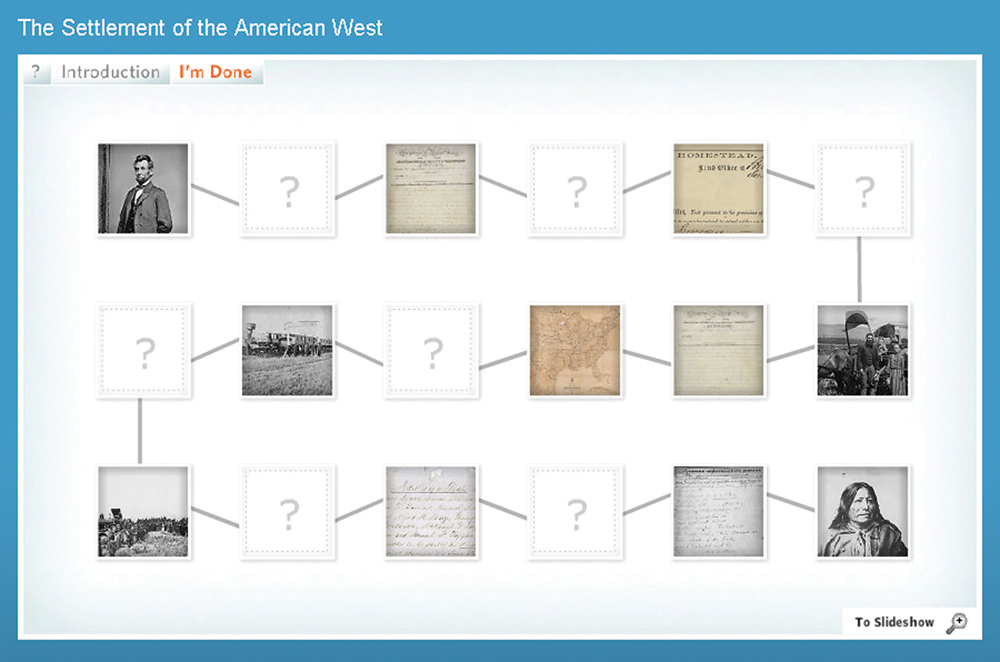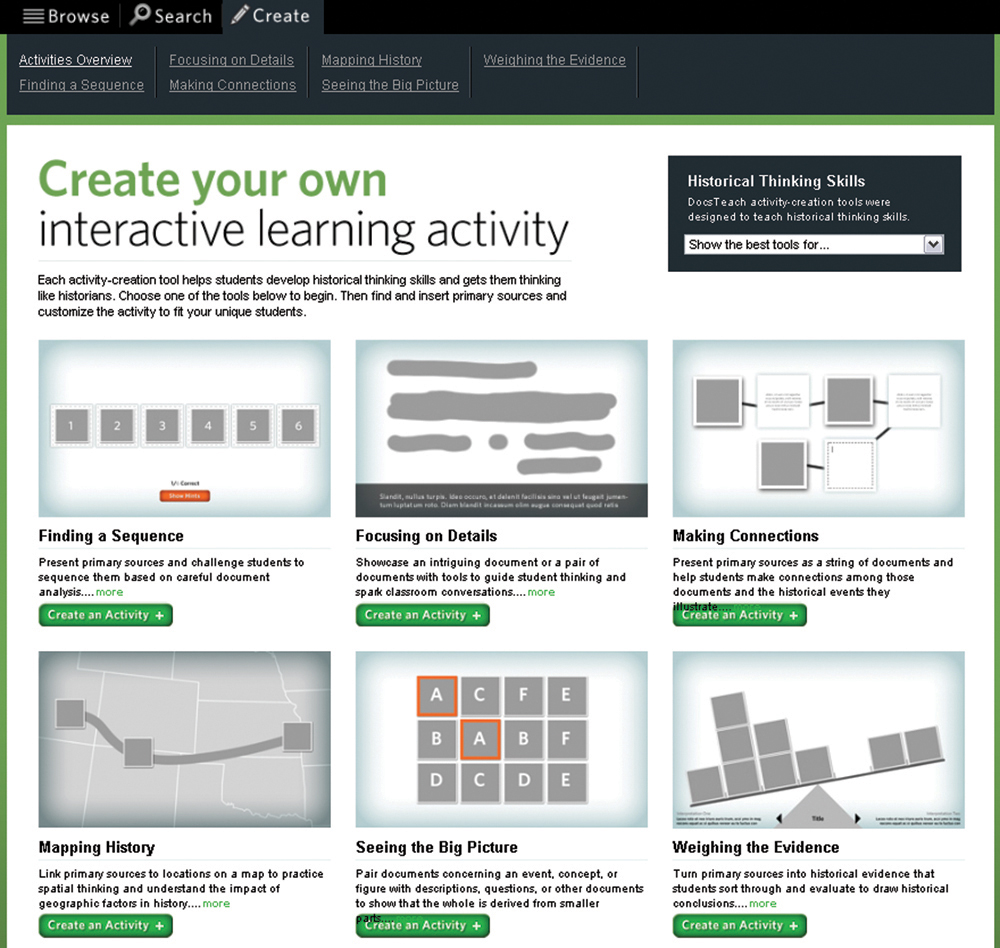
DocsTeach.org
The Archives Offers Teachers New Tools to Stir Student Interest in History
Fall 2010, Vol. 42, No. 3
By Stephanie Greenhut and Suzanne Isaacs
At the end of the American history unit on the Korean War and the Cold War, an eighth-grade student gets a homework assignment.
This assignment is different from all her other homework assignments. She is to go to a web site where a homework lesson created on DocsTeach.org from the National Archives awaits her.
The student is intrigued. Clicking, zooming, reading, and dragging is much more interesting than other assignments she's had.
This homework assignment, " What Kind of Leader Was General Douglas MacArthur?," really put the week's lesson in perspective. Now, by examining historical documents, photographs, and videos and placing them on a moving scale, she can evaluate the evidence for and against MacArthur and see if she agrees with President Harry S. Truman's decision to remove him from command.
In the end, the student places more documents on the side of the scale toward Interpretation One, which she labeled "General MacArthur was a great leader." But the activity isn't over yet. After clicking "I'm Done," she is asked some questions that challenge her choices:
What historical interpretation did the evidence best support?
Why did you place the documents where you did?
Which evidence do you think carried the most weight?
The follow–up questions make her go back and take a better look. There's much more to this assignment than just placing documents on a scale. She has learned to evaluate the credibility of historical records, to weigh information in light of all evidence presented, and to understand how historians combine evidence to arrive at historical conclusions.
This fall, teachers heading back to school will find a brand-new web site from the Center for the National Archives Experience and the Foundation for the National Archives to help them teach with records from the National Archives.
DocsTeach.org invites teachers to bring history to life for their students and gives them a powerful set of tools that they can use to create rich, interactive online learning activities.
From the home page, teachers can search for activities ready to use in the classroom, begin to explore the more than 3,000 documents featured from the holdings of the National Archives, or even create their own fun and engaging activities.
The National Archives has long invited citizens to practice civic understanding and exploration through America's historical documents.
For decades, the education program at the National Archives has been putting primary source documents into the hands of educators around the nation to inspire, intrigue, and motivate students. With DocsTeach.org, educators can still engage their students through primary sources, but in a new, interactive way.
"DocsTeach.org is a significant and welcome addition to our popular education programs," said Archivist David S. Ferriero. "It will engage teachers and students in new ways and stirs their interest in history through the use of original documents in the National Archives."
"It is also consistent with our goals to make as much of our holdings available to the public as easily as possible," he added.
Educators looking to find classroom-ready teaching activities on DocsTeach.org can use the Browse and Search features on the Activities page.
Teachers can readily find learning activities for the historical era they are teaching—by keyword or type of activity—based on the particular skill they'd like their students to practice. They can even search by activity author to find activities created by National Archives education specialists or by fellow educators around the country.
Information accompanies each activity so that teachers can determine if it is a fit for their classrooms. Along with a synopsis of the activity and instructions to the teacher, teachers can find out the historical era into which the activity fits, the historical thinking skill students will practice, and how much critical thinking it requires.
DocsTeach.org activities were designed to transform students into historians as they engage in primary source—based activities that develop historical thinking skills. Activities call upon students to analyze documents, focus on specific content, examine detail, and form their own hypotheses.
For example, teachers can assign students to compare and contrast military recruitment posters to analyze various perspectives regarding slavery and African Americans during the Civil War.
A teacher could present one activity to the entire class, displaying only part of a photograph showing an individual, with the rest obscured. He or she could ask students to guess what is going on in the rest of the photograph.
Students would need to closely examine this person's expression and body language, eventually identifying him as President Ronald Reagan and hypothesizing about what he is doing. The teacher could then share the entire photograph of the President and his staff watching a televised replay of the Space Shuttle Challenger explosion.
Students can also practice making connections among events or people or sorting through historical evidence to evaluate and draw historical conclusions.
Rather than simply reading about the settlement of the American West, for instance, on DocsTeach.org the students themselves need to fill in the connections between documents and photographs to tell the story of how the United States populated the West in the late 1860s and early 1870s.
Students can also engage in activities on DocsTeach.org that help them understand historical events, actions, and figures in historical and geographic context. A teacher might ask students to use maps to understand where certain New Deal programs took place, what kinds of jobs they provided, and how they affected regions of the country.
DocsTeach.org activities can also help teachers impart to their students how, in terms of historical events or results, the whole is derived of smaller parts.
To understand the broad-reaching impact of the United States Constitution, for instance, students can analyze documents that span the course of American history to determine their connections to the Constitution. Then they can make connections between the documents they have examined and the big ideas found within the Constitution.
DocsTeach.org is unique in the realm of education web sites. Unlike other web sites full of static lesson plans, DocsTeach.org allows teachers to adapt an activity that they've found and customize it for their own classrooms. Altering an activity is a simple and quick process. Teachers simply select the "Use to Create an Activity" button that accompanies every activity. They can edit activity information and student instructions and choose brand–new primary source documents for students to analyze.
Another inviting option for teachers is the ability to create an entirely new interactive learning activity for students.
Teachers will find the Create option on the DocsTeach.org Activities page and can choose from among seven tools, each designed to teach one or more historical thinking skills.
A professor of teaching methods who works with beginning teachers commented: "The tools are very clear and present a world of possibilities for new teachers—they will help teachers see that they can 'cover' content and get students involved in deep thinking at the same time."
The next step in creating an activity is to choose primary source documents from the more than 2,500 "teachable" records from the holdings of the National Archives, all selected by the education staff at the National Archives.
A teacher can then tailor the activity according to the goals he or she has for students, write instructions and questions for students, and include information to enable other teachers to borrow from this activity.
On DocsTeach.org, teachers can not only find, modify, and create activities but also save, assign, and manage their activities through their account. Each activity lives at its very own URL, or web address.
Teachers can choose a full-class activity,or they can ask students to access and complete the activity online, either in the classroom or from home. Students can even e–mail the results and their answers to their teacher when they've finished.
When educators register on DocsTeach.org, they can create and share their learning activities, borrow from a pool of activities created by fellow educators all over the country, and motivate their students to learn about our collective past in engaging interactive activities.
The selection of available learning activities will continue to grow as more teachers create accounts, craft activities, and share their creations with other registered educators.
Created to help not only new teachers but also teachers who want a new approach to teaching with primary documents, DocsTeach.org offers powerful teaching tools. Historical documents from the National Archives, chosen for classroom use, paired with best practices and a web environment, equals a dynamic experience for students.
Visit DocsTeach.org to become reacquainted with the history student inside of you!
Stephanie Greenhut is an education technology specialist at the National Archives and Records Administration in Washington, D.C. She creates instructional materials and tools using educational technologies and co-managed the production of DocsTeach.org.
Suzanne Isaacs is the digital projects coordinator for the National Archives Experience in Washington, D.C. She managed the production of the interactive exhibit The Digital Vaults and co-managed the production of DocsTeach.org.







